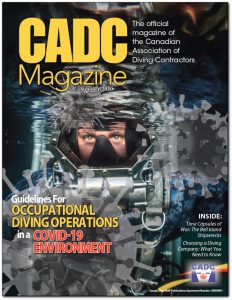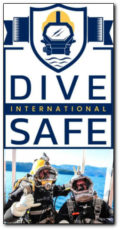CADC MAGAZINE SUMMER 2020 DIGITAL DOWNLOAD – GUIDELINES FOR DIVING OPERATIONS IN COVID-19 ENVIRONMENT ISSUE
By CADC Admin ~ June 1st, 2020. Filed under: CADC MAG, Safety.
 This issue of CADC Magazine has been a “stop the presses” moment. All planning for the publication—and our lives—ground to a halt with the COVID-19 pandemic.
This issue of CADC Magazine has been a “stop the presses” moment. All planning for the publication—and our lives—ground to a halt with the COVID-19 pandemic.
Articles ready for publishing went to the cutting room floor, held for a future edition. Getting appropriate information to our diving industry was top priority. To this end, we’re providing guidelines for working in a COVID-19 environment.
Diving services have been deemed essential in many countries. Among other things, we repair and maintain infrastructure for water supplies to cities and towns, maintain fisheries, and repair and inspect dams, piers, and bridges. We do the same offshore, repairing or maintaining structures for oil and gas.
Essentially, COVID-19 is a respiratory disease. Divers normally swap helmets and life support gear continuously, working in tight quarters. If you are exposed to and contract the disease, it could cause permanent lung damage, which affects breathing and gas transport and leads to problems in normal diving operations (decompression complications, etc.).
Translation: Even if one had it and survived, contracting COVID-19 could be career-ending. This is very serious.
This issue addresses the concerns of operating in this environment. At the time of publication (mid-to-late-May), operations are ramping up, as vital infrastructure repairs and maintenance projects begin.
Dive companies, some deemed “essential” in many jurisdictions, are working through the pandemic. Others, idle as distancing regulations were enforced, are now returning to a new, uncharted hazard. Namely, possible exposure to, or transmission of, COVID-19. Dive schools are adjusting teaching methods and course content, acknowledging that, for now, operations in a COVID-19 environment is a new normal.
On page 14, our lead article answers some of the frequently asked questions and provides guidelines for diving operations in a COVID-19 environment by linking to current information and advice from experts.
The pandemic has also impacted the Diver Certification Board of Canada (DCBC) and diving personnel: the inability of divers and supervisors to qualify to renew their certificates; the necessity for dive schools to cease operations until governments allowed them to re-open; cancelling the Canadian Underwater Conference and Exhibition. Flip to page 17 to read how David Parkes, CEO of the DCBC, explains the situation and how it affects you.
The health of our divers and support personnel has never been more important. We know “hot-swapping” diving equipment is common and often necessary. We also know that, unless appropriate proactive measures are taken, we run a serious risk of compromising the health of our team and jeopardizing the job. On page 20, Jonathan Chapple, vice-president of Aqua-Lung Canada Ltd., offers guidance collated from various equipment manufacturers for ensuring health risks are reduced and, hopefully, eliminated.
In this hazardous world of COVID-19 exposure, it’s critical to recognize employing an underwater contractor who’s ignorant of current safety standards and regulations can expose the employer to serious (and expensive) civil and criminal liability. Bill C-45 of the Criminal Code of Canada states it’s the legal duty of employers and those directing work to take reasonable measures to protect employee and public safety. If this duty is disregarded and bodily harm or death results, an organization could be charged with criminal negligence. Is this a risk you want to take? Learn more in the article by the Canadian Association of Diving Contractors on page 28.
On September 5, 1942, the German submarine U-513 rose from the depths of Conception Bay, Newfoundland, near Bell Island. Suddenly, the S.S. Saganaga and S.S. Lord Strathcona were struck by torpedoes, succumbing to the immense damage and sinking to their final resting place. Two months later, a second German submarine, U-518, entered the same anchorage to conduct a second attack. The first shot missed, detonating against the Scotia Pier. Without delay, U-518 fired upon the S.S. Rose Castle, who layed at anchor; the vessel was lost. All ordnance remained on the bottom for seven decades. Now, these steel giants are beginning to submit to the power of the sea, raising concerns for the safety of local divers. On page 23, Master Seaman Barry Macleod, Canadian Armed Forces, explores the national campaign to clear unexploded ordnance from these wrecks.
In January 2020, major changes came to the CSA Z275.2 Diving Operations Standard. The most contentious update now focuses on the requirement for a minimum four-person crew on all dive operations, including SCUBA. The crew is to consist of four competent individuals: supervisor, diver, standby diver, and tender. The updates came into effect on January 1, 2020. On page 26, Dave Shanahan of the CSA gives us a 50-year history of the development of our world-recognized Z275 dive standards.
Whether it’s heavy marine contracting, diving, salvage and environmental response, design, transportation, project management, or general contracting, CADC member Galcon Marine Ltd. is an industry leader in surface and subsurface marine construction. The profile by Dave Gallagher on page 30 looks at a project Galcon did for the City of Toronto to remove zebra mussels from a pipeline that went into 240 feet of water.
We now live and work in a changed environment. Our industry, our profession-of-choice, is about working and surviving in hostile environments—working on, and beneath, the water’s surface. To do that, we learn to adapt, to innovate. It’s what we do. Stay safe!
DOWNLOAD THE PDF VERSION (HYPERLINKED) – CADC MAG SUMMER 2020 Hyperlinked SM
VIEW ONLINE – VIEW MAGAZINE ONLINE






